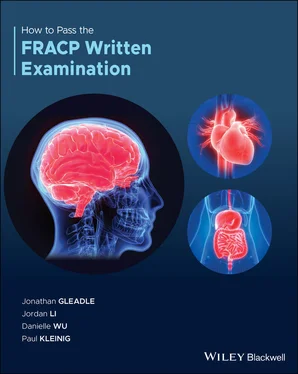While caring for critically ill patients with necrotising fasciitis the following complications should be close monitored:
Capillary leak syndrome: Circulating bacterial toxins and host cytokines cause diffuse endothelial damage. Intravenous fluid requirements may be extremely high (10 to 12 litres of normal saline per day). Profound hypoalbuminaemia is also common, and replacement with albumin is needed to maintain oncotic pressure.
Intravascular haemolysis: Bacterial haemolysins cause striking and rapid reductions in the haematocrit in the absence of DIC. Thus, the haematocrit may be a better indicator of the need for transfusion than the haemoglobin level.
Stress cardiomyopathy: necrotising fasciitis especially caused by streptococcal infection can cause global hypokinesia, severe systolic heart failure, low cardiac output. This cardiomyopathy is reversible, fully resolving in 3 to 24 months after infection.
Posterior reversible encephalopathy syndrome (PRES) is a clinico‐radiological syndrome characterised by headache, visual disturbances, seizures and altered consciousness. It is most commonly associated with accelerated and malignant hypertension. It can also be associated with eclampsia/preeclampsia, HUS, TTP, drug toxicity and very rarely sepsis. CT or/and MRI of the brain commonly show vasogenic oedema within the occipital and parietal regions, The oedema is usually symmetrical. PRES can be found in a non‐posterior distribution, mainly in watershed areas, including within the frontal, inferior temporal, cerebellar, and brainstem regions. Both cortical and subcortical locations are affected.

Stevens D, Bryant A. Necrotizing Soft‐Tissue Infections. New England Journal of Medicine. 2017;377(23):2253–2265.
https://www.nejm.org/doi/10.1056/NEJMra1600673
12. Answer: B
The updated paracetamol overdose management guidelines in 2019 recommend a two‐bag N‐acetylcysteine (NAC) infusion regimen (200 mg/kg over 4 hours, then 100 mg/kg over 16 hours) instead of the previous three‐bag regimen since they have similar efficacy and the two‐bag regimen has less adverse reactions. All patients with risks of hepatotoxicity secondary to paracetamol overdoses should receive NAC treatment. In patients with massive paracetamol overdoses which result in blood paracetamol level more than double the nomogram line should receive increased doses of NAC. In patients whose time of ingestion is unclear, it may be worthwhile to commence NAC infusion regardless given the unlikelihood of harm associated with the treatment.
The nomogram is only validated for a single ingestion of immediate release paracetamol. If extended‐release paracetamol is ingested, and or the overdose has occurred over a longer period of time, it is no longer validated. In these cases, NAC infusion should be commenced regardless, given the lack of harm. If there was co‐ingestion of opioids or anticholinergics, as they can affect gastric emptying and absorption of paracetamol, NAC should be given.
For patients who present within 2 hours of immediate release paracetamol overdoses or present within 4 hours of immediate release paracetamol ingestions greater than 30 gm, activated charcoal should be given in alert and co‐operative patients.
Only a small percentage of patients develop hepatotoxicity following acute paracetamol overdoses with symptoms that can include nausea, vomiting, abdominal pain, and right‐upper quadrant tenderness. Of these patients, a small number of patients develop fulminant hepatic failure. Most patients recover after standard treatment.
Liver transplant unit should be consulted if patients meet any of the following criteria:
INR >3.0 at 48 hours or >4.5 at any time.
Oliguria or serum creatinine is >200 μmol/L.
Persistent acidosis (pH <7.3) or arterial lactate >3 mmol/L.
Systolic blood pressure <80 mmHg, despite fluid resuscitation.
Hypoglycaemia, severe thrombocytopenia, or encephalopathy.
Any alteration of consciousness (GCS <15) not associated with concomitant sedative overdoses.

Chiew A, Reith D, Pomerleau A, Wong A, Isoardi K, Soderstrom J et al. Updated guidelines for the management of paracetamol poisoning in Australia and New Zealand. Medical Journal of Australia. 2019;212(4):175–183.
https://onlinelibrary.wiley.com/doi/abs/10.5694/mja2.50428
13. Answer: C
Pulseless electrical activity (PEA), previously known as electromechanical dissociation (EMD) is defined as the absence of a palpable pulse in an unconscious patient with organized electrical activity other than VT on ECG. The proportion of PEA among cases of sudden cardiac arrest increases with age. Females are more likely to develop PEA than males. Patients with PEA are more likely to have one or more co‐morbidities than those in the VF/VT group. However, PEA is less likely to occur in those with CCF. In one study, PEA was responsible for 68% of monitored in‐hospital deaths and 10% of all in‐hospital deaths.
PEA more commonly has an underlying cause of the arrest including the Hs and Ts listed below and the most frequent causes are hypoxemia secondary to respiratory failure and hypovolemia due to internal bleeding or a recent haemodialysis. This patient’s PEA is possibly due to hypoxia caused by his infective exacerbation of COPD. Tension pneumothorax also needs to be excluded.
Hs
Hypoxia
Hypovolemia
Hydrogen ion (acidosis)
Hypokalaemia/ hyperkalaemia, hypoglycaemia
Hypothermia
Ts
Toxins
Tamponade (cardiac)
Tension pneumothorax
Thrombosis (massive PE or AMI)
Trauma
The overall prognosis for patients with PEA arrest is dismal unless a rapidly reversible cause is identified and corrected. Only 11% of patients who have PEA as their first documented rhythm survives to hospital discharge. ECG characteristics are related to the patient's prognosis. The more abnormal the ECG characteristics, the less likely the patient is to recover from PEA; patients with a wider QRS (>0.2 sec) have worse prognosis.
PEA is treated in the same way as asystole. It is not a shockable rhythm. You should continue with CPR, administer epinephrine and begin to consider possible causes. Epinephrine can be given every 3 to 5 min.

Pulseless Electrical Activity: Background, Etiology, Epidemiology [Internet]. Emedicine.medscape.com. 2019 [cited 17 August 2019]. Available from: https://emedicine.medscape.com/article/161080‐overview

The Australian Resuscitation Council Guidelines [Internet]. Resus.org.au. 2019 [cited 17 August 2019]. Available from: https://resus.org.au/guidelines/
14. Answer: B
Patients with critical illness are at risk of upper gastrointestinal bleeding, a condition that may be associated with increased mortality. Clinically important gastrointestinal bleeding occurs in 3–5% of ICU patients. Until recently guidelines have recommended preventive therapy with either histamine H 2–receptor antagonists or proton‐pump inhibitors (PPIs) for patients in ICU who are at risk for stress ulceration and bleeding. However, any benefit from PPIs might be reduced by harmful events that are associated with the use of these agents, including nosocomial pneumonia, Clostridium difficile enteritis, and myocardial ischemia. The use of enteral feeding may also reduce the risk of gastrointestinal bleeding.
Читать дальше
















